Art
Art Basel’s Day-One Sales Show Demand for Fresh Work Is Undented, While Secondary Material Receives More Price Scrutiny
Some collectors opted to skip Basel entirely this year. And there’s a risk-off attitude among those who did show up, as some wonder whether now would be a better time to buy bonds than art.
U.S. collector Mihail Lary, returning to the fair for the first time since lockdown, noted that while gold seemed to be a prominent feature in many of the artworks on offer, some might be thinking that “maybe gold bars would be a safer bet during the continuing political and financial upheavals.”
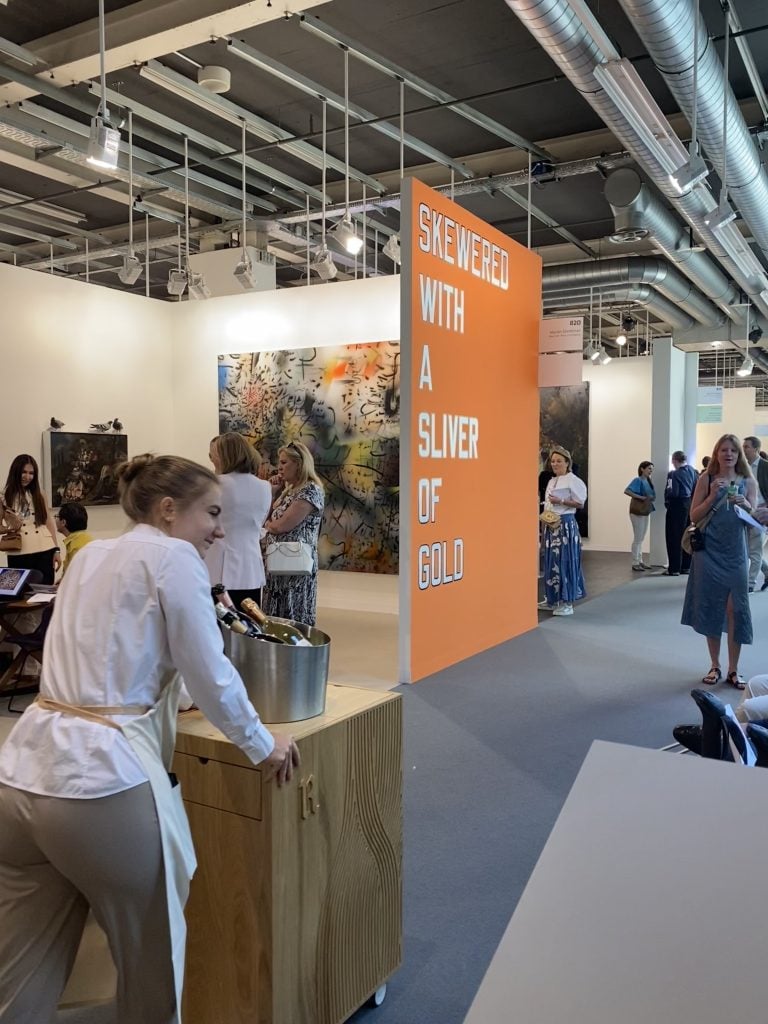
Art Bael 2023. Photo by Naomi Rea.
That sentiment dovetails with a strongly felt general sense that art prices, which had long been spinning out of control, were finally about to hit a ceiling. “I think that generally art took a massive inflation,” advisor Sibylle Rochat told Artnet News. “Any fairly nice painting by a mid-career artist [without massive institutional support] is now around $300,000, which is too expensive in my opinion. Young artists with a bio the size of a stamp are now $30,000 to $50,000. Before, emerging art was what was making the art world accessible. It’s not anymore, and the joy is gone.”
As a result, galleries were working harder than ever ahead of time to stage-manage the success of the fair. The preview PDFs were heavier than ever— Art Basel will have a big job in front of it ensuring that every gallery does indeed present every work they said they would bring—and there was vigorous pre-selling activity in the run-up to the fair.
Collector Jens Farschou noted that Gagosian’s preview clocked in at around 120 works and David Zwirner’s at around 200. “In my opinion, these activities around the fair have become a circus and have not much to do with the original concept of an art fair,” he said. “The beautiful thing about the art fair—especially Art Basel—is that the entire world gathers around the art.”
Perhaps as a reaction to the desire to see art in a less transactional tone—as well as in person, for many who are just now returning to live events since lockdown—there was a sense that gallerists took more care with their booth presentations at the fair this year. One advisor noted that the dealers might be catering toward “fewer advisors, more curators” due to the exit of the investors from the art-buying arena. Among the curators spotted roaming the booths were Cecilia Alemani, Carolyn Christov-Bakargiev, and Doryun Chong, Rhein Wolfs, Daniel Birnbaum, and Alexie Glass-Kantor.
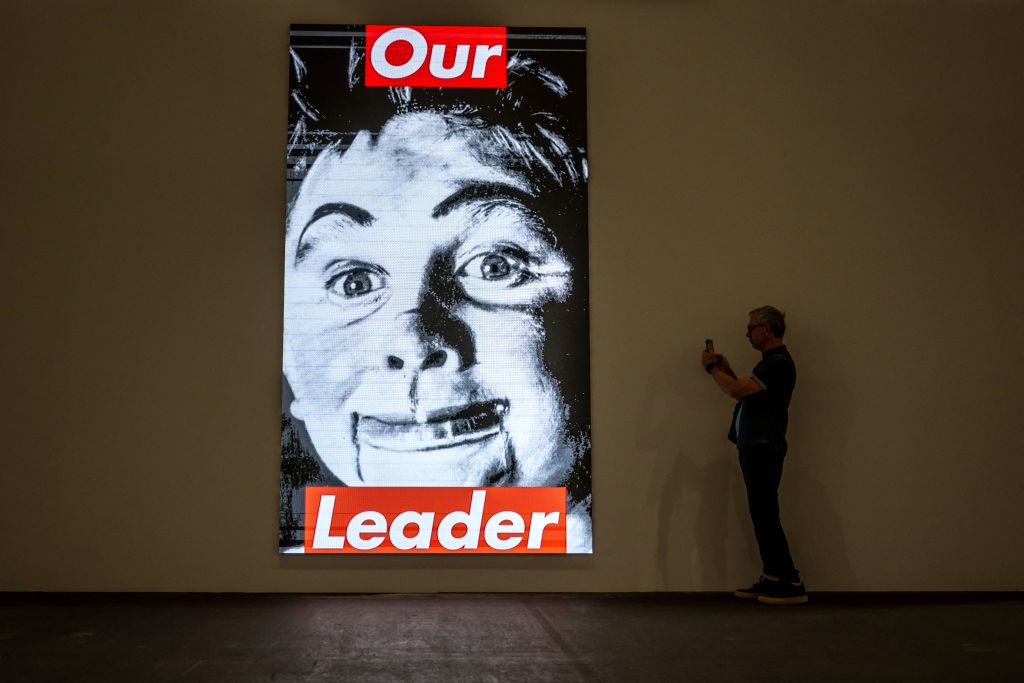
A visitor takes a picutre next to “Untitled (Our Leader)” 1987/2020 by US conceptual artist Barbara Kruger, displayed at the Unlimited section of the Art Basel fair for Modern and contemporary art, in Basel, Switzerland on June 13, 2023. Photo by Fabrice Coffrini/AFP via Getty Images.
Last year, the blue-chip galleries were devoting ground-floor real estate to younger artists side by side with their established names on the fair’s first day, reflecting the ravenous market for emerging art, which was being leveraged to help support of the rest of their programming. This year, there was a return to form with classic blue-chip fare taking center stage. There was also a feeling that booths were better curated, even outside of the Features section devoted to historical solo presentations, and Kabinett, a new sector for curated offerings.
A highlight for Swiss collector Suzanne Syz was Sadie Coles HQ’s solo presentation of Laura Owens in the main section. “The fair was not as hectic, but that’s a good thing. The art market was too crazy,” Syz said. “I think it’s good that it comes down to a normal level. It was not healthy, especially for young artists who were getting burned.”
Syz couldn’t help herself from buying a Philippe Parreno “speech bubble” work at Pilar Corrias, despite the fact that the pieces are not the easiest to own, as they require reinflation every three months. There was a fair amount of sculpture being placed with collectors, suggesting an intent to live with the art, rather than two-dimensional paintings that are more easily stored—and flipped.
“If there’s a recalibration, it’s that people are not buying art for ridiculous prices, but they are certainly buying art for the right prices,” Pace gallery president Marc Glimcher told Artnet News. Among the gallery’s first-day sales were a Calder mobile for $2.8 million, three editions of an Elmgreen & Dragset lifeguard sculpture for between $350,000 and $425,000, and, yes, several coveted pencil drawings by Yoshitomo Nara for an undisclosed price. A $14 million Joan Mitchell triptych on view, however, hadn’t found a buyer by day’s end.
The sale reports coming in at the end of day one attested to continued demand on the primary market for young artists, especially those whose auction results are on the upswing. David Kordansky sold a Lucy Bull painting for between $100,000 and $150,000, as well as a Chase Hall for an undisclosed price. Xavier Hufkens sold two paintings by Ulala Imai for between $90,000 and $125,000, ahead of an exhibition with the artist at their Brussels gallery slated for September.
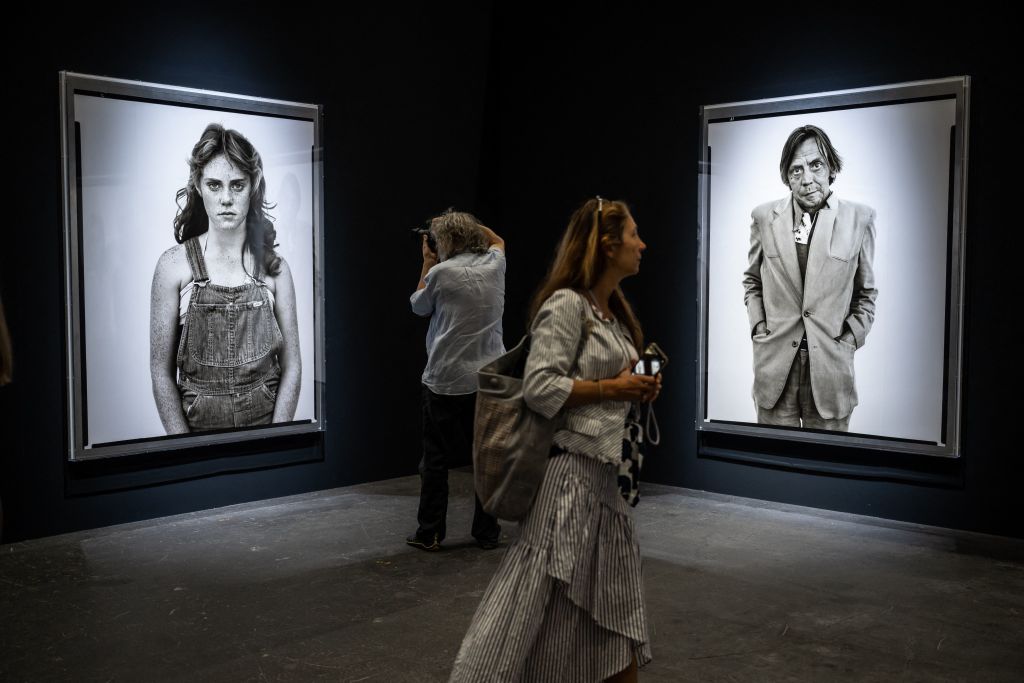
Visitors walk past pictures by US photographer Richard Avedon at “the Ten Exhibition Prints from In the American West, photographed 1979-1984” booth at the Art Basel fair for Modern and contemporary art, in Basel, Switzerland on June 13, 2023. Photo by Fabrice Coffrini/AFP via Getty Images.
There were strong results for blue-chip contemporary art as well. Hufkens also sold a glass sculpture in two parts by Roni Horn for approximately $2.5 million; Lisson gallery’s sales included a Sean Scully painting for $875,000; and Hauser and Wirth sold a Rashid Johnson “Seascape” for $975,000.
Many more sales were reported from galleries across the market spectrum by day’s end. At Art Unlimited, the fair’s section for works too big to be shown in a booth, David Zwirner sold a Barbara Kruger for $1.3 million and a Gerhard Richter for $2.5 million. White Cube sold a new sculpture by Doris Salcedo, who is the subject of a much-talked-about exhibition on view at the Fondation Beyeler, to a major institution for $1.125 million, and almost the entire edition of new Georg Baselitz sculptures for €1.7 million each.
Goodman Gallery placed Shirin Neshat’s Land of Dreams (2019) with a South Asian institution for $275,000, and the Louisiana Musuem of Modern Art acquired Zineb Sedira’s DREAMS HAVE NO TITLES (Lightbox) (2023) for €80,000. Lehmann Maupin sold a Tom Friedman sculpture for $300,000 to a U.S. collector. Stephen Friedman parted with a Luiz Zerbini painting for $285,000. Pippy Houldsworth, who had a stunning solo presentation of Jacqueline de Jong, sold one painting, Pendant La Chute, for €160,000. And in the Statements section for younger positions, Soft Opening sold well from its solo presentation of Sin Wai Kin: two editions and corresponding “facial wipe” works for $22,000 and $29,000, and one additional “facial wipe” work for $7,000.
While the reported first-day results indicate no demand ceiling on the primary market, the secondary market does seem to have been more impacted by the uncertainty in the auction market, with the recalibration being seen in slower-to-move material and increased opacity on pricing.
Some buyers said it was indeed easier to acquire works that would have been inaccessible to them 24 months ago, particularly on the emerging side of the spectrum, reflecting, as advisor Wendy Goldsmith put it, a “last-chance saloon” attitude towards certain lesser-quality works by hot names. No one wants to be left holding a B+ painting when it all goes south, after all.
David Zwirner took the surprise decision not to disclose prices on secondary-market sales made this year, and reported to press that he would no longer do so going forward. That makes it hard to gauge whether such sales by his gallery—of works by Joan Mitchell, Marlene Dumas, Gerhard Richter, or Agnes Martin—reflected a more rational pricing environment or not.
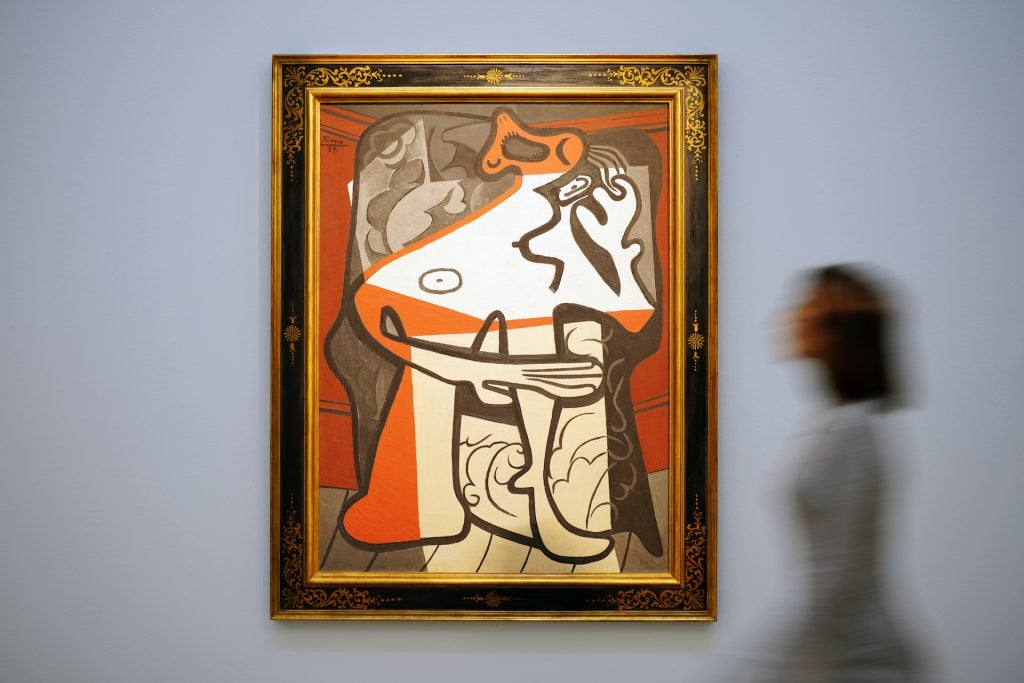
Pablo Picasso’s Femme dans un fauteuil (1927), estimated at Sotheby’s in 2022 $15-20 million, it sold for $9 million. Photo by Michael Bowles/Getty Images for Sotheby’s.
Still, there is scarcity at the top. There is a finite supply of works by the most expensive artists, who have established value points. Robert Landau, of Landau Fine Art, a renowned dealer of Impressionist and Modern art, was therefore confident in the $25 million asking price for a beguiling 1927 Picasso portrait of Marie-Thérèse Walter. Laundau bought the painting, which was once in the collection of ex-Whitney president David Solinger, at auction in November for $9.9 million, a steal compared to its estimate of between $15 million and $20 million.
“You cannot just look at the auction price. You have to look at the painting,” he said. “You cannot overpay for a good picture. You can overpay for a bad picture, and you’ll never get your money back. But if you overpay for a good picture, time will correct your mistake.”
Landau acknowledged that there has been a market adjustment, estimating prices are down by around 25 percent on both the primary and secondary markets—”when it rains, it rains everywhere,” he said—and he pointed to a clear culprit: art dealers following the lead of the auctions and inflating the prices of living artists to “crazy” levels. “It’s not healthy, and I think they chased away confidence in the market,” he said. Landau does not share sales information but said he was certain the painting would find a good home.
No word, either, from Acquavella Galleries, which brought an exquisite orange Rothko painting formerly in the collection of Paul Mellon and reportedly consigned by mega-collector Steve Wynn with an asking price of $60 million (it last sold publicly in 2014 for $36.6 million).
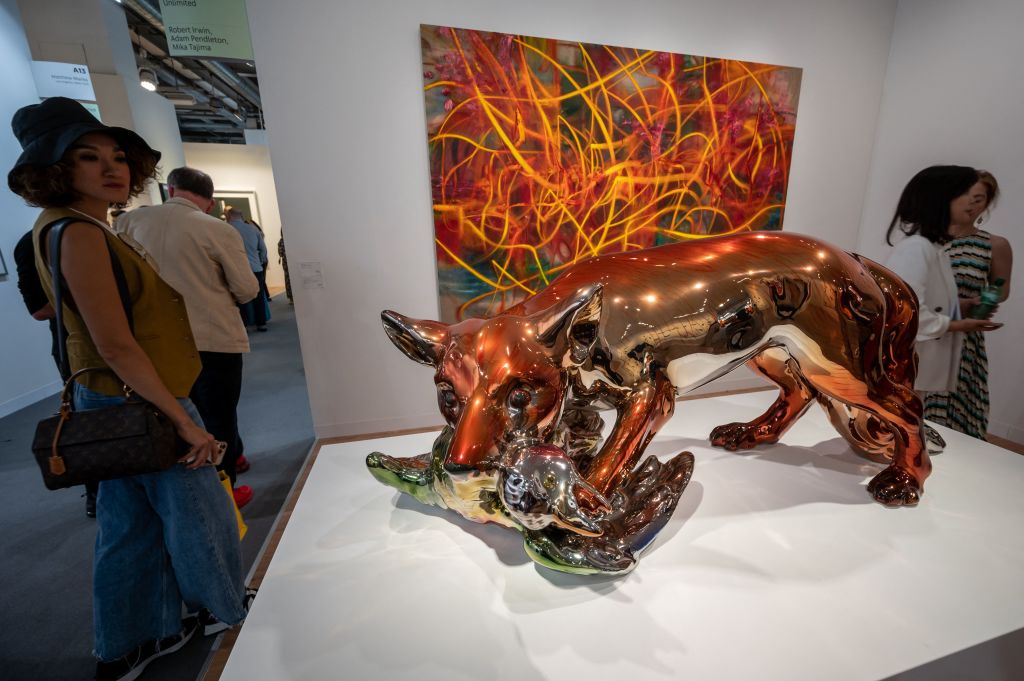
Fox with Bird (2016-2023) by US artist Jeff Koons, displayed at the gallery Pace during the Art Basel fair for modern and contemporary art, in Basel, Switzerland. Photo by Fabrice Coffrini/AFP via Getty Images.
A lot of quality expensive material did move on the first day, however. Hauser and Wirth sold a wall-mounted Louise Bourgeois spider, which was priced at $22.5 million, a 36 percent markup on the price for which it was acquired by its consignor last April at Sotheby’s Hong Kong. “It’s Basel at its best. It’s the center of gravity,” Iwan Wirth said. The gallery also found a home for a rare Bourgeois “Personages” sculpture for $7.5 million, and a $9.5 million Philip Guston painting.
By day’s end, Gagosian had sold more than 40 works, including a Cecily Brown painting Artnet News understands was priced at $6 million (Gagosian does not disclose prices).
Larry Gagosian said it was “too soon to tell” if a market recalibration is truly under way. Despite appearances at the auctions, he said: “I think things are picking up; the second half of the year will be very strong. We’re having a great fair, so I’m very encouraged.”
All told, while top-end prices may have become more rational, and deals were being cut at a more considered pace, gallerists said they were generally doing better, in terms of both sales volume and average price, compared to last year. So, what’s the big-picture takeaway for Art Basel 2023 so far? Yes, a market recalibration is likely underway. But, perhaps moving the focus away from record-setting prices and back onto the artistic achievements behind the headlines isn’t such a bad thing.

Art
Calvin Lucyshyn: Vancouver Island Art Dealer Faces Fraud Charges After Police Seize Millions in Artwork

In a case that has sent shockwaves through the Vancouver Island art community, a local art dealer has been charged with one count of fraud over $5,000. Calvin Lucyshyn, the former operator of the now-closed Winchester Galleries in Oak Bay, faces the charge after police seized hundreds of artworks, valued in the tens of millions of dollars, from various storage sites in the Greater Victoria area.
Alleged Fraud Scheme
Police allege that Lucyshyn had been taking valuable art from members of the public under the guise of appraising or consigning the pieces for sale, only to cut off all communication with the owners. This investigation began in April 2022, when police received a complaint from an individual who had provided four paintings to Lucyshyn, including three works by renowned British Columbia artist Emily Carr, and had not received any updates on their sale.
Further investigation by the Saanich Police Department revealed that this was not an isolated incident. Detectives found other alleged victims who had similar experiences with Winchester Galleries, leading police to execute search warrants at three separate storage locations across Greater Victoria.
Massive Seizure of Artworks
In what has become one of the largest art fraud investigations in recent Canadian history, authorities seized approximately 1,100 pieces of art, including more than 600 pieces from a storage site in Saanich, over 300 in Langford, and more than 100 in Oak Bay. Some of the more valuable pieces, according to police, were estimated to be worth $85,000 each.
Lucyshyn was arrested on April 21, 2022, but was later released from custody. In May 2024, a fraud charge was formally laid against him.
Artwork Returned, but Some Remain Unclaimed
In a statement released on Monday, the Saanich Police Department confirmed that 1,050 of the seized artworks have been returned to their rightful owners. However, several pieces remain unclaimed, and police continue their efforts to track down the owners of these works.
Court Proceedings Ongoing
The criminal charge against Lucyshyn has not yet been tested in court, and he has publicly stated his intention to defend himself against any pending allegations. His next court appearance is scheduled for September 10, 2024.
Impact on the Local Art Community
The news of Lucyshyn’s alleged fraud has deeply affected Vancouver Island’s art community, particularly collectors, galleries, and artists who may have been impacted by the gallery’s operations. With high-value pieces from artists like Emily Carr involved, the case underscores the vulnerabilities that can exist in art transactions.
For many art collectors, the investigation has raised concerns about the potential for fraud in the art world, particularly when it comes to dealing with private galleries and dealers. The seizure of such a vast collection of artworks has also led to questions about the management and oversight of valuable art pieces, as well as the importance of transparency and trust in the industry.
As the case continues to unfold in court, it will likely serve as a cautionary tale for collectors and galleries alike, highlighting the need for due diligence in the sale and appraisal of high-value artworks.
While much of the seized artwork has been returned, the full scale of the alleged fraud is still being unraveled. Lucyshyn’s upcoming court appearances will be closely watched, not only by the legal community but also by the wider art world, as it navigates the fallout from one of Canada’s most significant art fraud cases in recent memory.
Art collectors and individuals who believe they may have been affected by this case are encouraged to contact the Saanich Police Department to inquire about any unclaimed pieces. Additionally, the case serves as a reminder for anyone involved in high-value art transactions to work with reputable dealers and to keep thorough documentation of all transactions.
As with any investment, whether in art or other ventures, it is crucial to be cautious and informed. Art fraud can devastate personal collections and finances, but by taking steps to verify authenticity, provenance, and the reputation of dealers, collectors can help safeguard their valuable pieces.
Art
Ukrainian sells art in Essex while stuck in a warzone – BBC.com
[unable to retrieve full-text content]
Ukrainian sells art in Essex while stuck in a warzone BBC.com

Source link
Art
Somerset House Fire: Courtauld Gallery Reopens, Rest of Landmark Closed
The Courtauld Gallery at Somerset House has reopened its doors to the public after a fire swept through the historic building in central London. While the gallery has resumed operations, the rest of the iconic site remains closed “until further notice.”
On Saturday, approximately 125 firefighters were called to the scene to battle the blaze, which sent smoke billowing across the city. Fortunately, the fire occurred in a part of the building not housing valuable artworks, and no injuries were reported. Authorities are still investigating the cause of the fire.
Despite the disruption, art lovers queued outside the gallery before it reopened at 10:00 BST on Sunday. One visitor expressed his relief, saying, “I was sad to see the fire, but I’m relieved the art is safe.”
The Clark family, visiting London from Washington state, USA, had a unique perspective on the incident. While sightseeing on the London Eye, they watched as firefighters tackled the flames. Paul Clark, accompanied by his wife Jiorgia and their four children, shared their concern for the safety of the artwork inside Somerset House. “It was sad to see,” Mr. Clark told the BBC. As a fan of Vincent Van Gogh, he was particularly relieved to learn that the painter’s famous Self-Portrait with Bandaged Ear had not been affected by the fire.
Blaze in the West Wing
The fire broke out around midday on Saturday in the west wing of Somerset House, a section of the building primarily used for offices and storage. Jonathan Reekie, director of Somerset House Trust, assured the public that “no valuable artefacts or artworks” were located in that part of the building. By Sunday, fire engines were still stationed outside as investigations into the fire’s origin continued.
About Somerset House
Located on the Strand in central London, Somerset House is a prominent arts venue with a rich history dating back to the Georgian era. Built on the site of a former Tudor palace, the complex is known for its iconic courtyard and is home to the Courtauld Gallery. The gallery houses a prestigious collection from the Samuel Courtauld Trust, showcasing masterpieces from the Middle Ages to the 20th century. Among the notable works are pieces by impressionist legends such as Edouard Manet, Claude Monet, Paul Cézanne, and Vincent Van Gogh.
Somerset House regularly hosts cultural exhibitions and public events, including its popular winter ice skating sessions in the courtyard. However, for now, the venue remains partially closed as authorities ensure the safety of the site following the fire.
Art lovers and the Somerset House community can take solace in knowing that the invaluable collection remains unharmed, and the Courtauld Gallery continues to welcome visitors, offering a reprieve amid the disruption.
-

 Sports19 hours ago
Sports19 hours agoArmstrong scores, surging Vancouver Whitecaps beat slumping San Jose Earthquakes 2-0
-

 News19 hours ago
News19 hours agoAs plant-based milk becomes more popular, brands look for new ways to compete
-

 News16 hours ago
News16 hours agoLabour Minister praises Air Canada, pilots union for avoiding disruptive strike
-

 News55 mins ago
News55 mins agoNova Scotia premier repeats calls for Ottawa to pay for protecting Chignecto Isthmus
-

 News56 mins ago
News56 mins agoEmir of Qatar to visit Ottawa on what will be his first official trip to Canada
-

 News55 mins ago
News55 mins agoTIFF audience prizes for ‘Life of Chuck,’ Hip doc; Rankin among Canadian winners
-

 News16 hours ago
News16 hours agoLooking for the next mystery bestseller? This crime bookstore can solve the case
-

 News19 hours ago
News19 hours agoInflation expected to ease to 2.1%, lowest level since March 2021: economists





















